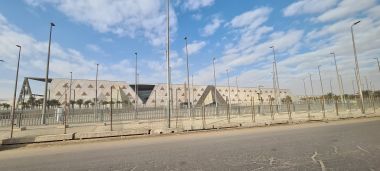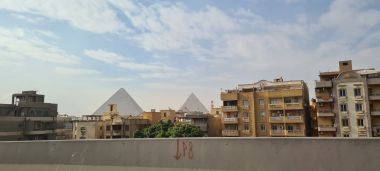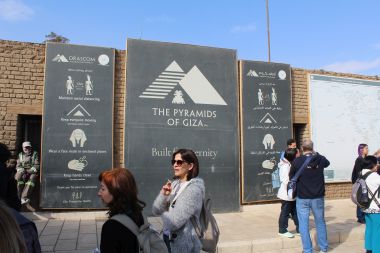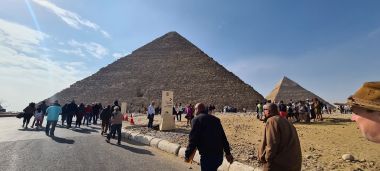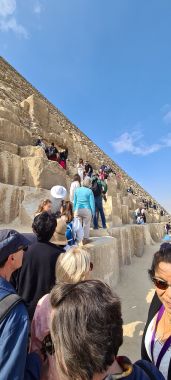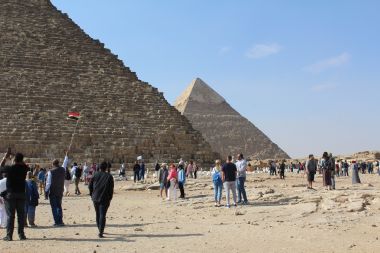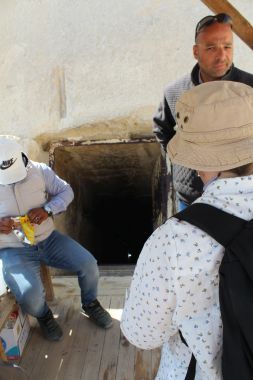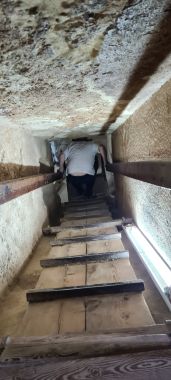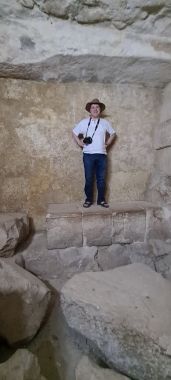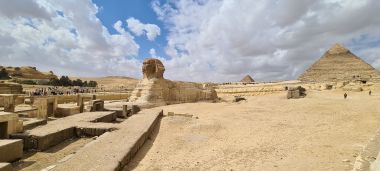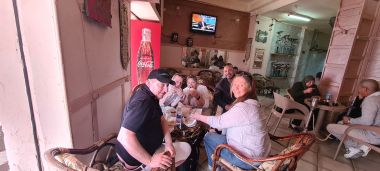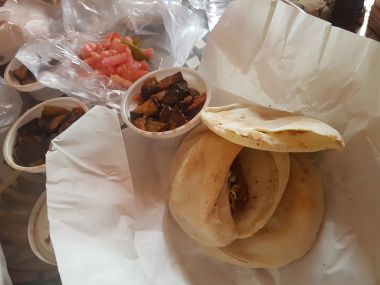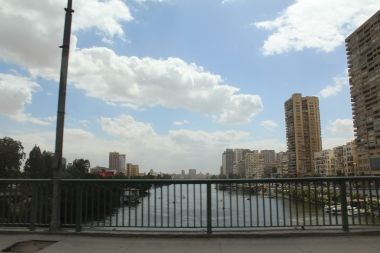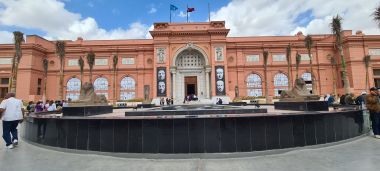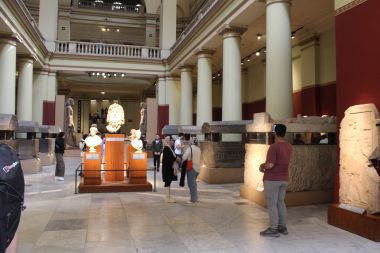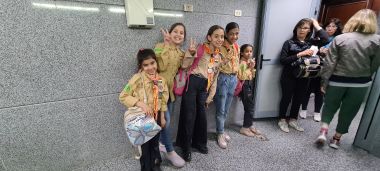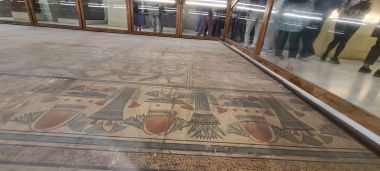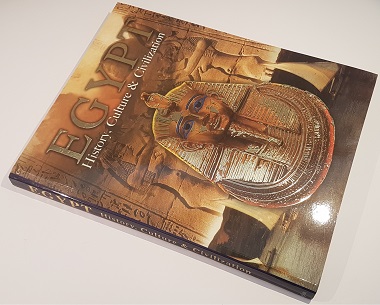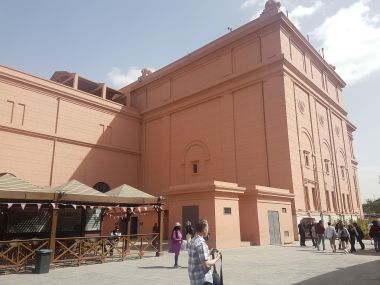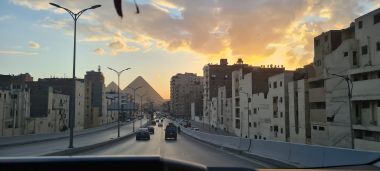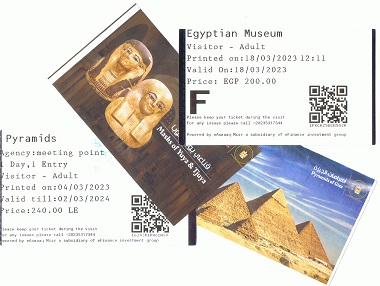Day 10 - Giza Plateau and Egyptian Museum - March 18, 2023
It was another long day. I can't believe how much we have done but are now quite exhausted.
Our pick up was scheduled for 7:45 am at the hotel so we set the alarm for 6:30 so we could have breakfast and still have plenty of time before we left. The breakfast was buffet style in a restaurant on the right side of the lobby. A central island had cereal, drinks and breads while a counter in the wall had the hot offerings and another table along the window held fresh fruit and porridge. The food on offer was much like we had on the cruise though I was pleasantly surprised to see they also had falafel.
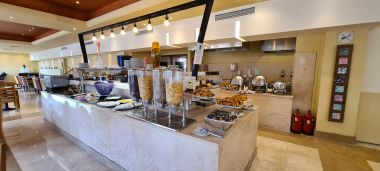
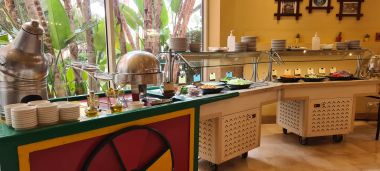
We were alone with the driver, Abdoul, for the trip into Cairo. Initially we travelled along some back roads that we learned was quite a common way to get between major highways. Travelling into the city we passed on the road immediately below the Giza Plateau, where the pyramids are, and past the site of the “Grant Egyptian Museum” which is currently under construction and due to open within the year (quite behind schedule) - A massive, flat modern structure featuring triangular motifs throughout it's architecture. This museum will eventually house the complete Tutankhamun collection and will be the largest archaeological museum complex in the world. When this new museum opens the existing Cairo museum will be closed for (much needed) refurbishment.
Passing by the pyramids, looming above us, we proceeded into the city itself, leaving the main roads and travelling along the side streets.
Life is a cacophony with scooters here there and everywhere, bush taxis (local van transport carrying 16 or so people), taxis, cars and the occasional horse cart. Traffic goes anywhere there is a free space including the sidewalks and people calmly walk across the street with little regard to the vehicles which magically go around them. The side streets and beside the roads is all dirt. The apartment buildings are dull grey affairs that show evidence of vibrant life within - Laundry hanging outside, air conditioning units, and people sitting on their porches observing the drama around them. Most of the apartment buildings are 12 or 14 stories, so not terribly tall. On the ground floor of every building there is an assortment of shops selling pretty much everything you can imagine. Most signs are in Arabic but there is frequent English as well. There are local shops as well as big multinationals with a dealership for Jaguar beside a hair dressing salon which is beside a fruit and veg seller. Yes, there are the McDonalds and KFCs as well.
The other English couple were staying in a hotel that we had a bit of difficulty initially finding. We travelled on the bumpy, narrow dirt roads between various apartment blocks before coming to a dead end at the wall of a motorway where, turning right, we found ourselves at the main entrance of their hotel where they were waiting. Evidently they can see the pyramids from the upper floors of their hotel (through the cityscape of tall buildings surrounding them). Yes, rub it in. We boasted of our view of our vacant lot adjacent to the hotel. Our guide for the trip, Ahmed joined us here.
Our first visit was to the Giza Plateau and as we returned there we passed by a very busy bush taxi depot which seemed to have hundreds of vans waiting for passengers, or dropping them off. They are all beige or white in colour with long windows for the passengers to look out, a driver and what we called in Gambia, an “aparenté” - someone what shoats out the destination, helps people on board, loads/unloads luggage, and collects the fare.
It has been remarked by many but it is interesting to se that the pyramids are literally in the middle of the city. Approaching from the north we left the highway and were immediately on a road winding up a sand mound up to the Giza plateau where we arrived at a heaving car park. We were deposited as close as the driver could get to the modern visitor centre where we waited while Ahmed arranged our entry. As we waited I read the Covid “do's and don'ts” for the site which featured symbols of ancient Egypt such as a picture of King Tut's death mask with a face covering, and two God's practicing safe social distancing.
Eventually Ahmed took us through the standard security onto the site. As we followed the paved road up to our right was the incredible sight of the 139 meter Pyramid of Khufu, otherwise known as the “Great Pyramid”, the largest of the three largest pyramids here. I say the “three largest” as there are, in fact, nine pyramids here with six smaller pyramids belonging to various royal women. Of course the site also features the great sphinx on the eastern side and numerous other historical sites including graveyards.
There were a lot of tourists here so we walked around a bit to find somewhere for Ahmed to talk to us. Eventually we stopped near to the entrance to the Grand Pyramid, about 50 feet up with a line of visitors slowly making their way up to. Above the entrance is the opening to a newly discovered hidden corridor that is blocked to visitors.
The pyramids which house the tombs of ancient pharaohs were created by earlier rulers than those found in the Valley of the Kings about a 1,000 years earlier. After construction the great pyramids were looted fairly quickly (they are hard to miss) so later pharaohs went to greater pains to hide their tombs from discovery.
After a short introduction to the area Ahmed took our pictures posing in front of the pyramids. This would turn out to be what we did at most sites, with very little background or history given to us. Passing around to the north east corner of the Great pyramid we were able to see the pyramid in all it's glory. You are no longer allowed to climb the pyramids which is just as well as some stones are almost as high as I am! The stones are a bit worn. We were told that originally the entire surface of the pyramid would have had a flat surface but weather and erosion has taken it's toll. There were a number of dogs laying on the lower stones of the pyramids which attracted the attention of tourist cameras.
Where we found ourselves is where you can rent a donkey cart, horse or camel for a trip around the plateau, evidently at a fixed rate of 500 FE. The camels, of course, would be the way to do it and these are the most plentiful garishly decorated with woven coloured clothes.
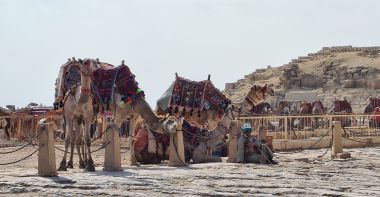
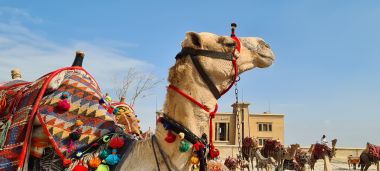
A huge rectangular pit here was where the “Khufu boat”, a 144 foot wooden planked ship, was excavated in the 1950s. The boat, we were told, was used to transport blocks of stone for the pyramids on the nearby Nile. Nearby was a smaller pyramid of Queen Hetepheres (see Pyramid G1-a) which we were told would be a good place to visit. Indeed this was the case with no one in the queue to get in, we approached the base of the pyramid where there was a small canopy and several local people watching over things.
Much like the tombs of the Valley of the Kings the pyramid tomb structure consists of a steep, narrow entrance leading to burial chambers. In this case the access shaft was perhaps 2.5 to 3 feet high and descended for about 50 meters at a 45 degree angle. They had helpfully provided wooden railings on either side, with the occasional light and there were wooden slats on the ground to climb on but even so it took some time to travel down the shaft backwards, having first checked to make sure no one else was trying to come up.
At the bottom there was a large room that you could stand up in then, at a sharp right, another 2-3 meter shaft leading down to another much larger room, the burial chamber itself which was quite tall and had some large stones in it (a small metal ladder helpfully placed to descend to the floor). I was first into the chamber and made my way to the far end so I could get pictures of the rest of our group entering.
The space was well lit but poorly ventilated so was quite stuffy. We must have been about 50 meters below the surface and other than our gasping breath and the occasional spoken comment it was very quiet. The spaces were completely unadorned and lined with the beige limestone used for all of the pyramid structures. One of our group was claustrophobic having been locked in a crate by his brother when he was a child so he was keen to leave…Returning to the surface I found much easier and pretty much raced back out, dropping my hat as I left the tunnel and having it offered back to me (only later I was told that the local's hand was out for a tip for picking up my hat, but I had blithely ignored this).
After the pyramid we wandered around for a few minutes taking a load more pictures (including more of some nearby puppies posing appropriately) before being taken back to the van which now took us up a narrow, busy road, past the Great pyramid then the smaller Pyramid of Khafre to the west and the modern “King Khufu Center” which I have learned is the main visitor centre (rather than simply the entrance) for the plateau. The winding road took us to a large, high, car park where we had a great view of the plateau and the city beyond…as well as of camel caravans of visitors. The car park was packed with tour buses and an assortment of souvenir stalls, as you might imagine.
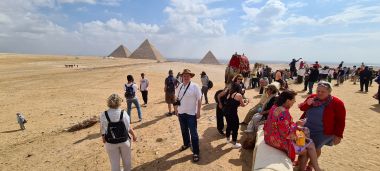
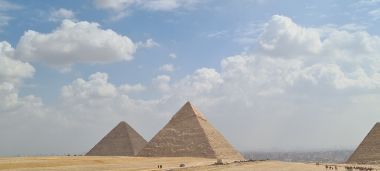
This was simply a photo stop so after we did that we returned to the van which then took us back along the road but turned to the right onto a road that travelled immediately behind the Great Pyramid (to the south), behind the pyramids of the three queens which we had visited earlier than down past the Sphinx where we had to quickly jump out of the van to take pictures. This was not to be a stop as the van inched it's way through the traffic we took what pictures we could of the Sphinx, only a short distance from the road, with the pyramids beyond. There is a path leading to a viewing platform immediately in front of the famous statue but we did not have enough time for that. There were a lot of kids here and people walking down the road incline towards the eastern plateau exit. Access to the area around the Sphinx is strictly by booking an expensive (£1,000?) visit in advance so when a couple of kids climbed down from the road they were immediately yelled at by a security guard. The base of the statue is much better preserved than the upper parts due to it being buried in sand. Further along is the seating for the evening light show which we found out was quite pricey and not recommended by Ahmed.
Giza Plateau Pictures (from Flickr)
Earlier I had mentioned that I would love to visit a local falafel shop as I had been told that falafels in Egypt are quite unusual in that they are made from fava beans instead of chickpeas which are used everywhere else. So, Ahmed had promised to take us to his favourite falafel shop to give them a try so this is what we did next. The busy shop was tiny and at the junction of several small streets with a menu completely in Arabic. Ahmed told us to stay put and hopped out of the van to place the order. I got out as well to take a look into the kitchen which was a small white tiled room open to the street beside the restaurant which had a huge vat of deep frying oil, as well as several big metal bowls of fava beans soaking in the corner. This was most definitely local and I was quite happy to see a bit more of the way modern Egyptians really live and eat.
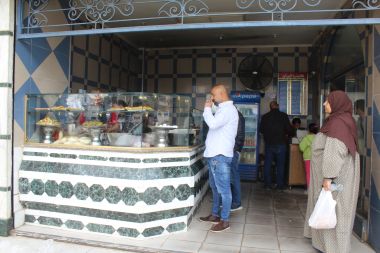
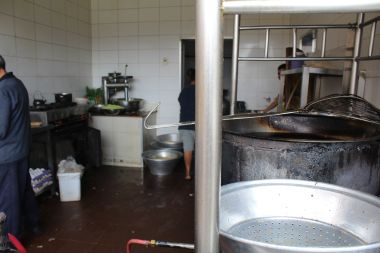
Eventually we had our food and were directed to a small local café where we grabbed a table near the door. Though a different establishment we were allowed to eat there as long as we bought a drink so it was mint tea all around. The furnishings were old sofas and chairs with a TV in a corner showing what looked to be news. Shisha pipes were piled in the corner but the place was not terribly busy. There were toilets but we were told by one of our party that there was no toilet paper (though we were prepared by this point).
The falafel was amazing - We each had three small pitas with a single falafel each but with slightly different toppings, one of which was quite spicy. There were dips as well including tahini, cucumbers, aubergine, and salty pickles that you were free to add as you wish…The falafel were lovely and creamy, absolutely delicious. Some of the best, and certainly most authentic, falafel I have ever had. They were 10 LE including the separate toppings so quite a good deal.
One of the other things we had mentioned to Ahmed earlier was that we wanted to visit the Egyptian museum. We were in Cairo and this was one thing that I had always wanted to do and I had managed, with not any amount of persuasion, to convince the rest of our group to go. Ahmed was perfectly fine with this, telling us it would cost 70€ each which would include everything (parking, entrance, guiding, etc, etc). So after our falafel snack the next stop was the famous The Egyptian Museum in Cairo.
We were taken across the Nile back into the heart of the city. The large, impressive neo-classic building is clad with red painted sandstone on the banks of the Nile. It was built between 1897 and 1903, housing many of the great historical artefacts of Egypt including those of King Tutankhamun but, not, it must be said, the Rosetta stone which is housed in The British Museum in London (a facsimile is on display here in Cairo). We were dropped at the front gates by the driver who then went off to find somewhere to park. We passed through the normal security while Ahmed arranged our tickets. While waiting the sun shade umbrella of a guard blew away causing a bit of embarrassment as it knocked over the guard and his chair. Chuckles all around as he gathered himself back up. We took the opportunity to take some pictures and appreciate the façade of the museum and the grounds in front. A large fountain flanked by two sphinxes was, unfortunately, not working. On the far left of the site (near the river) is a monument to the architect, Marcel Dourgnon while all around the area are tall palm trees. A haven from the bustling city surrounding us.
Climbing up the steps then through the narrow, but impressive, entrance, we passed through security scanners before entering the museum itself. Under the impressive rotunda the museum spread out ahead and to the left and right of us on the ground level and the level above. Two large statues of pharaohs greeted visitors while the marble flooring also impressed. This is Victorian architecture at it's best. The museum consists of a number of themed rooms containing numerous artefacts that are often not well labelled if at all. This is a museum that is very much in need of renovation and so the new Grand Museum is very much welcomed to be able to show these amazing artefacts in surroundings that are suitable to their magnificence.
Ahmed quickly ushered us to the left to view some impressively carved and painted false doors taken from tombs. These are doorways that mark the threshold between the living and the dead at which offerings could be left. On the way to the second level we stopped at the toilets on the staircase as it was already 12:30 pm and we were in need of a pit stop. A group of girl scouts insisted on Mel taking their picture…While I was looking at a display of papyrus showing the weighing of souls (on death your soul's weight was compared that of a feather - If you were a good person your soul would be lighter than a feather, otherwise…).
On the upper level we passed through a room containing many beautifully decorated sarcophagi presented simply in glass cases or on the floor. Back at the central rotunda we were able to take in the impressive open space to the ceiling dominated by huge arches and glass windows.
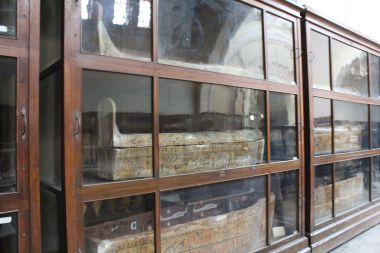
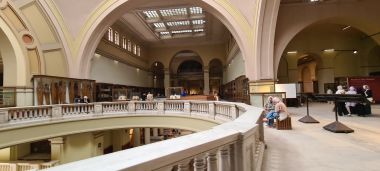
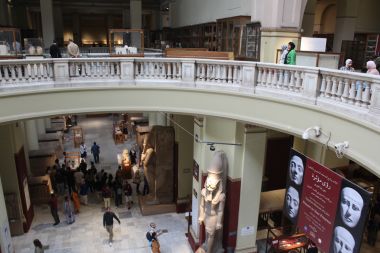
We next visited the “Animal Mummy Room” which included embalmed animals including crocodiles, snakes, monkeys, cows, cats, and dogs. The crocodiles here seemed to be even bigger than those we had seen at Temple of Kom Ombo. All a bit morbid.
We next made our way to the back of the upper level where there was, of course, the highlight of the museum and that is the artefacts of King Tutankhamun. The most important pieces are in a room where no photos can be taken but outside of this there are a number of items such as the king's chair featuring a famous picture of the boy king and his wife, a golden shrine box protected by four guardians (“selket”), and his alabaster canopic jars (containing his vital organs).
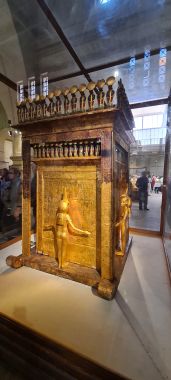
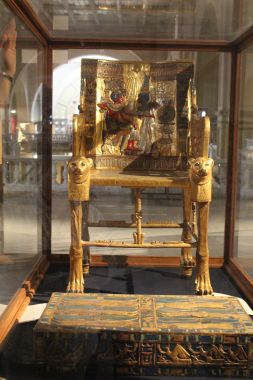
The small room containing the priceless pieces of course features King Tutankhamun's golden death mask, his 110 kg gold gilt sarcophagus and his first bow along with display cabinets featuring a lot of smaller, beautiful, artefacts including amulets many of which also made of gold. At this point we were given 20 minutes in the museum to have a look around before meeting Ahmed out the rear exit. Mel and I took the opportunity to just wander to take it all in including stopping in another treasure room where photography was not permitted. We admired a colourful painted plaster pavement from a palace, more sarcophagi and mummies, sphinxes, carved entrances, huge statues of not only pharaohs but also of their Gods and more fanciful images of animals and humans.
There is a lot of dust around and we noticed several places where boxes were just stacked in the corner. They definitely need more space as the museum is not terribly large and quite busy. For the most part people are respectful of the exhibits but we did see some people touching them, perhaps to feel that what they are seeing is actually real.
Leaving the museum we felt a bit cheated of having not been able to spend more time here. I took a few minutes to go through the rather large gift shop near the exit at the back of the museum looking for a reasonable book about Egypt settling on one recommended by Ahmed which talks about the historic sites and has many pictures but also written details which I have felt have been lacking today.
We waited in the shade outside of the giftshop for the driver to come pick us up with a small eating area opposite including a small truck selling fish and chips.
Egyptian Museum Pictures (from Flickr)
Next up was the obligatory trip to a local (tourist) shop. This time it was a shop selling Egyptian cotton on a small road running alongside a highway in the middle of the city. There was no pretence here of actually explaining how the fabric is made and we immediately faced the sell. Mel and I were actually interested in shirts and here there were plenty of them in many designs and styles. We eventually settled on some shirts for a total of £30 but at one point they were showing us some sheets that were on sale for approximately £250. A bit steep for us (!). The others, including Ahmed, waited for us watching television in a small back waiting area.
Included in our travel package for today was lunch (not drinks, just food). Despite it being 3:30 pm and our having had an earlier meal of falafel Ahmed insisted on us visiting the buffet restaurant just across the (busy) road (literally) from the pyramids. We were taken around the front and up a flight of stairs into the restaurant which was quite nice but definitely a tourist trap. As it was so late the buffet had closed so they brought food out to us which, perhaps, was far worse as they attempted to be generous despite all of us not being terribly hungry and took our not eating too much as a bit of a slight and insisting on bringing out more…It started with pita and all the accompaniments - pickles, hummus, then a vegetable soup starter with rice, mains were fries, rice, grilled chicken, fish and kofta while dessert was kind of like baklava - a heavy, sweet pastry followed by orange slices. They kept bringing out food even when we said we did not want any more and eventually they gave each of us a container full of dessert left overs alongside a questionnaire that they waited for us to complete (yep, excellent, let's get out of here…).
After our reluctant meal I visited the neighbouring petrol station with one of our fellow tourists for him to pick up some cash as he was running low and Ahmed wanted us to settle up on the trip to the museum (for which I had used both British and Egyptian pounds) and they had been told that they had not paid for the trip to Alexandria tomorrow (though we had). The driver dropped the other couple at their hotel along with Ahmed before taking us back to ours though we were delayed for quite some time due to horrendous traffic stopped due to construction. We took some more side roads before finally coming up on the hotel from behind.
Back in the hotel it was nice to connect with my mother via WhatsApp. She was very much interested in what we were doing so we talked for some time.
Tomorrow is another big travel day with the trip up to Alexandria, about 225 kilometres to the north of Cairo on the Mediterranean Sea. Luckily we can sleep in a bit as they will be picking up the other couple from their hotel first before coming to get us.
Our stomachs are not happy…perhaps the revenge of the restaurant that we did not want to visit? Oh dear…
⇒ Continue to Day 11 - Alexandria - March 19, 2023
